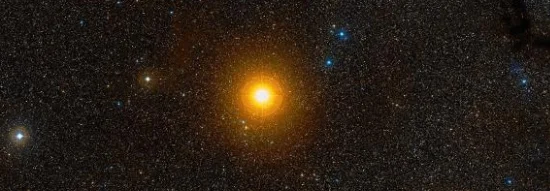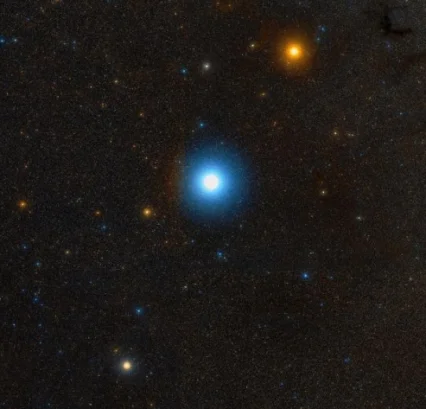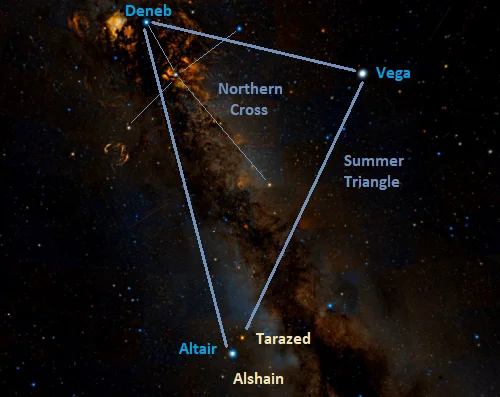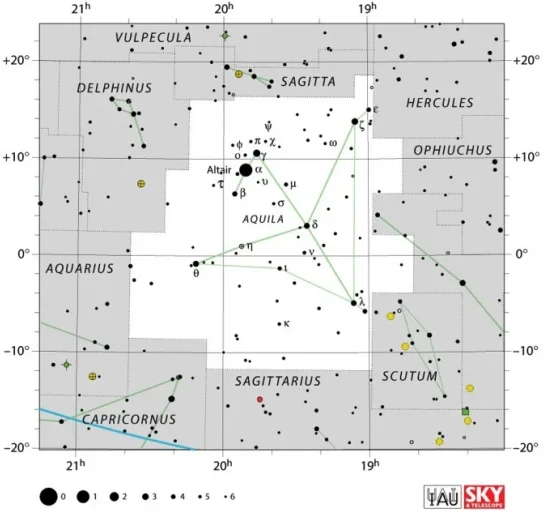Tarazed, Gamma Aquilae (γ Aql), is an orange bright giant star located in the constellation Aquila (the Eagle). With an apparent magnitude of 2.712, it is the constellation’s second brightest star, after Altair. Tarazed lies at a distance of 395 light years. It is recognizable as the brighter of the two stars flanking the bright Altair.
Star type
Tarazed has the stellar classification K3 II, indicating a bright giant star appearing orange in colour. The star has a mass 3.51 times that of the Sun and has expanded to a size of 91.81 solar radii as it evolved away from the main sequence. Now it is burning helium into carbon in its core. With a surface temperature of 4,098 K, it is 2,146 times more luminous than the Sun.
Tarazed spins faster than the Sun, with a projected rotational velocity of 8 km/s. Its estimated age is 270 million years.
Even though it is a young star, Tarazed has evolved faster than the Sun because it is 3.5 times more massive. It is, however, not massive enough to end its life as a supernova. Instead, when it comes to the end of its life cycle, it will expel its outer layers to form a planetary nebula and slowly fade away as a white dwarf.

Tarazed (Gamma Aquilae), image: Wikisky
In 1991, the Catalogue of WBVR-magnitudes of bright stars of the northern sky reported Tarazed to be slightly variable, but the star’s variability has not been confirmed.
Facts
Tarazed forms an asterism known as the Shaft of Aquila with the brighter Altair (Alpha Aquilae) and fainter Alshain (Beta Aquilae). The three stars form a line about 5 degrees in length that is also known as the Family of Aquila.

Altair, Tarazed and Alshain (the Shaft of Aquila), image: Wikisky
Tarazed has the designation Gamma Aquilae even though it is the constellation’s second brightest star and considerably brighter than Alshain (Beta Aquilae). It is uncertain why the 17th century German astronomer Johann Bayer, who assigned Greek letter designations to stars based on the order of magnitude, designated Alshain (mag. 3.87) Beta and the much brighter Tarazed Gamma.
In Chinese legend, Altair, Vega, Tarazed and Alshain are associated with the tale of the Cowherd (Niulang) and the Weaver Girl (Zhinü). Niulang and Zhinü (represented by Altair and Vega) were a couple who fell in love, but their relationship was not allowed and they were banished to opposite sides of the great river in the sky, symbolized by the Milky Way. They were only able to meet once a year, when magpies would form a bridge across the river. In the tale, Tarazed and Alshain represent their children. The legend dates back more than 2,600 years and is associated with the Qixi Festival, an annual event that celebrates the meeting of the pair on the seventh day of the seventh lunisolar month of the Chinese calendar.
To the Koori people of Victoria in southeast Australia, Altair represented Bunjil, a wedge-tailed eagle, while Tarazed and Alshain represent his wives, two black swans.
Name
The name Tarazed (pronunciation: /ˈtærəzɛd/) comes from the Persian phrase šāhin tarāzu, meaning “the beam of the scale.” It refers to a Persian asterism formed by Altair, Tarazed and Alshain. The word šāhīn means “beam,” but also “royal falcon” and “pointer.” The “falcon” meaning went to Alshain, Beta Aquilae (derived from šāhīn).
The name Tarazed was approved by the International Astronomical Union’s (IAU) Working Group on Star Names (WGSN) on August 21, 2016.
The 17th century Egyptian astronomer Al Achsasi Al Mouakket referred to Gamma Aquilae as Menkib al Nesr, meaning “the shoulder of the eagle.” The name was later translated into Latin as Humerus Vulturis.
In Chinese astronomy, Tarazed is known as 河鼓三 (Hé Gŭ sān), the Third Star of River Drum. It forms the Chinese River Drum asterism with Alpha and Beta Aquilae (Altair and Alshain). The asterism represents military drums in the sky and is part of the larger Ox mansion, one of the northern mansions of the Black Tortoise.
In Hindu astronomy, Tarazed formed the 21st nakshatra (lunar mansion), called Çravana (the Ear), with Altair and Alshain. The asterism was associated with the Sacred Fig Tree (Açvattha) and ruled by the god Vishnu. It represented the Three Footsteps the god took as he strode through the heavens.
Location
Tarazed is very easy to find because it flanks Altair, the 12th brightest star in the sky. Altair is part of a prominent asterism, the Summer Triangle, which dominates the evening sky during the northern hemisphere summer. It forms the Summer Triangle with the bright Vega in the constellation Lyra, the fifth brightest star in the sky, and Deneb in Cygnus, the 19th brightest star. Deneb is identified as the star at the top of the Northern Cross, a conspicuous asterism that outlines the body of the celestial Swan. Vega appears next to the parallelogram pattern that represents the lyre of Orpheus and gives the constellation Lyra its name. Altair is recognizable as the star flanked by two other relatively bright stars, Alshain and Tarazed. Tarazed is the brighter of the two.

The location of Alshain and Tarazed, image: Wikisky
Constellation
Tarazed is located in the constellation Aquila. Associated with the eagle that carried Zeus’ thunderbolts, as well as with the eagle that carried Ganymede to Mount Olympus to serve as cupbearer to the gods, Aquila is one of the Greek constellations. It was first catalogued by the Greek astronomer Ptolemy in his Almagest in the 2nd century BC.
Aquila is the 22nd largest of all 88 constellations. It occupies 652 square degrees of the northern sky between Sagitta and Delphinus to the north, Aquarius to the east, Ophiuchus to the west, and Sagittarius to the south. The constellation’s bright stars Altair, Okab (Zeta Aquilae), Theta Aquilae, Delta Aquilae, and Lambda Aquilae outline the body of the celestial Eagle that can be seen flying opposite Cygnus, the Swan.

Aquila constellation map by IAU and Sky&Telescope magazine
Aquila hosts many interesting stars. These include Altair, the 12th brightest star in the sky, the orange giant Epsilon Aquilae, the Cepheid variable Eta Aquilae, the fast-spinning Okab (Zeta Aquilae), and the carbon star V Aquilae.
The constellation is also home to several notable deep sky objects. These are the globular cluster NGC 6760, the open clusters NGC 6709, NGC 6749 and NGC 6755, and the planetary nebulae NGC 6751 (the Glowing Eye Nebula), NGC 6741 (the Phantom Streak Nebula), NGC 6804, NGC 6778, and NGC 6781.
The best time of year to observe the stars and deep sky objects in Aquila is during the month of August, when the constellation is prominent in the evening sky. The entire constellation can be seen from locations between the latitudes 90° N and 75° S.
The 10 brightest stars in Aquila are Altair (Alpha Aql, mag. 0.76), Tarazed (Gamma Aql, mag. 2.712), Okab (Zeta Aql, mag. 2.983), Theta Aquilae (mag. 3.26), Delta Aquilae (mag. 3.365), Lambda Aquilae (mag. 3.43), Alshain (Beta Aql, mag. 3.87), Eta Aquilae (mag. 3.87), Epsilon Aquilae (mag. 4.02), and 12 Aquilae (mag. 4.02).
Tarazed – Gamma Aquilae
| Spectral class | K3 II |
| U-B colour index | +1.720 |
| B-V colour index | +1.500 |
| Apparent magnitude | 2.712 |
| Absolute magnitude | -3.38 (-3.14 to – 3.6) |
| Distance | 395 ± 8 light years (121 ± 2 parsecs) |
| Parallax | 8.26 ± 0.17 mas |
| Radial velocity | -2.693 ± 0.0005 km/s |
| Proper motion | RA: +16.99 ± 0.18 mas/yr |
| Dec.: -2.98 ± 0.08 mas/yr | |
| Mass | 3.51 ± 0.23 M☉ |
| Luminosity | 2,146 ± 139 L☉ |
| Radius | 91.81 R☉ (89.69 – 94 R☉) |
| Temperature | 4,098 ± 56 K |
| Metallicity | -0.29 dex |
| Age | 270 ± 40 million years |
| Rotational velocity | 8 km/s |
| Surface gravity | 1.52 cgs |
| Constellation | Aquila |
| Right ascension | 19h 46m 15.5802908s |
| Declination | +10° 36′ 47.740788″ |
| Names and designations | Tarazed, Gamma Aquilae, γ Aql, Reda, 50 Aquilae, HD 186791, HR 7525, HIP 97278, SAO 105223, BD+10 4043, AG+10 2518, FK5 741, GC 27354, GCRV 12137, IRAS 19438+1029, 2MASS J19461557+1036475, PPM 136931, PLX 4645, JP11 3130, NSV 24880, UBV 16822, TYC 1061-2577-1, Gaia DR2 4302054339950301696, CCDM J19462+1037A, IDS 19415+1022 A, WDS J19463+1037D |